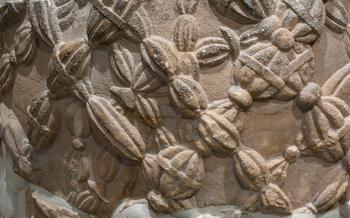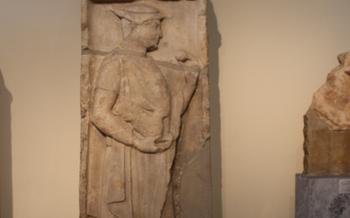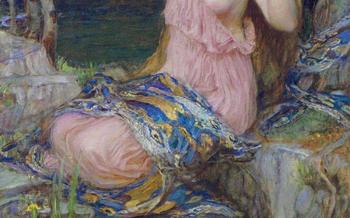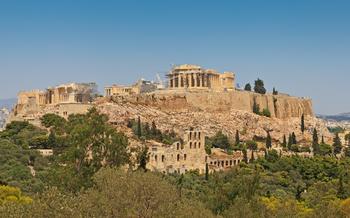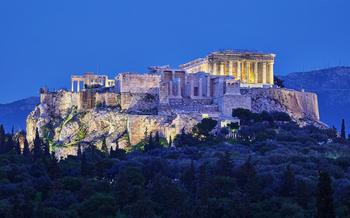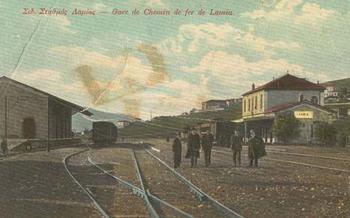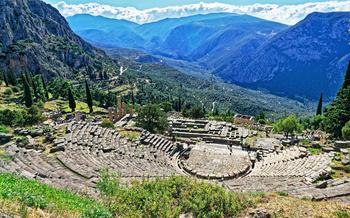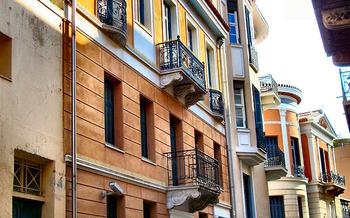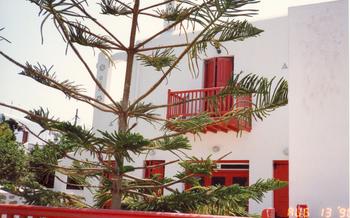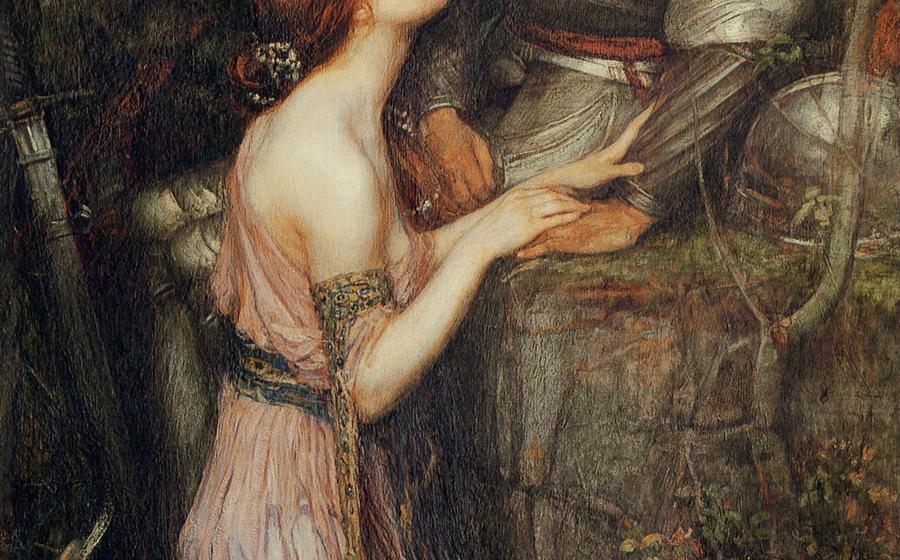
Domokos Archaeological Museum
- Historical Overview
- Location and Accessibility
- Museum Highlights
- Ancient Artifacts
- History and Culture
- Interactive Displays
- Mythology and Legends
- Local Craftsmanship
- Conservation and Restoration
- Educational Programs
- Museum Shop
- Family-Friendly Activities
- Photography and Social Media
- Accessibility Features
- Insider Tip: Unveiling the Ancient Theater of Domokos
Historical Overview
Lamia, a city steeped in ancient history, served as the capital of the Malian tribe during the Classical Greek period. Situated in central Greece, it played a significant role in the region's rich tapestry of civilizations. The surrounding area, including the town of Domokos, boasts a wealth of archaeological treasures that provide invaluable insights into the region's past.
The Domokos Archaeological Museum, a testament to the region's cultural significance, houses an impressive collection of artifacts unearthed from various archaeological sites, spanning from the Neolithic period to the Late Roman era. Through its exhibits, the museum offers a glimpse into the diverse cultures that have shaped this region, highlighting the continuity and evolution of human settlement and artistic expression.
Location and Accessibility
The Domokos Archaeological Museum is situated in the heart of Domokos, a charming town in the Phthiotis region of Central Greece. To reach this historical gem, visitors can navigate through the picturesque streets of Domokos, following signs that lead to the museum. The exact address is 25th of March Street, Domokos 350
For those arriving by car, ample parking is available near the museum. Alternatively, regular bus services connect Domokos to major cities like Athens, Thessaloniki, and Larissa, making it easily accessible by public transportation. The museum's operating hours are from 8:30 AM to 3:00 PM, Tuesday through Sunday, with a one-hour break between 1:00 PM and 2:00 PM. Admission fees are minimal, ensuring affordability for all visitors.
Museum Highlights
The Domokos Archaeological Museum houses a remarkable collection of artifacts that showcase the rich history and culture of the region. Among the highlights are the exquisite Neolithic figurines, dating back to 7000 BC. These clay sculptures depict humans and animals with intricate details, providing a glimpse into the artistic expression and religious beliefs of the early inhabitants. Equally impressive are the Bronze Age tools and weapons, which demonstrate the advanced craftsmanship and technological prowess of the ancient metalworkers.
One of the most captivating exhibits is the 7th-century BC bronze statue of a kouros, or young man. Standing at over 5 meters tall, the statue is a testament to the skill and artistry of the ancient Greek sculptors. The kouros exhibits a graceful stance and a serene expression, embodying the ideals of beauty and harmony that would become hallmarks of Classical Greek art.
The museum also features an impressive collection of pottery from various periods, including Mycenaean, Geometric, and Classical. These vessels, adorned with intricate designs and motifs, offer insights into the daily life, customs, and artistic traditions of the ancient Greeks. Among the most notable pieces is a 6th-century BC amphora depicting a scene from the Trojan War, showcasing the sophisticated storytelling and narrative abilities of the ancient potters.
Ancient Artifacts
Among the countless treasures within the Domokos Archaeological Museum lies a captivating collection of ancient artifacts that offer a glimpse into the lives and cultures of past civilizations. One exceptional artifact is the intricate Neolithic figurine crafted from clay. Its delicate features, adorned with intricate designs, evoke a sense of mystery and artistry that transports visitors to a time when mythology and ritual were intertwined. Another notable artifact is an impressive Bronze Age tool, remarkably well-preserved and showcasing the advanced craftsmanship and ingenuity of its creators. Its polished surface and sharp edges suggest a multitude of purposes, from hunting and agriculture to symbolic rituals.
Perhaps the most awe-inspiring artifact is a stunning gold pendant discovered in a nearby ancient tomb. Its intricate filigree and intricate patterns reveal the exceptional skill and artistry of ancient goldsmiths. Experts believe it may have been worn by a high-ranking official or a member of the royal family, symbolizing power, wealth, and prestige. Every artifact in this museum tells a story, connecting visitors to the rich tapestry of ancient Greek history and culture, making the Domokos Archaeological Museum a true treasure trove for history enthusiasts and culture lovers alike.
History and Culture
The Domokos Archaeological Museum takes visitors on a journey through time, showcasing artifacts from various periods of history. The Neolithic period, dating back to 6000 BC, is represented by exquisite figurines and tools, offering a glimpse into the lives of early settlers. The Bronze Age, spanning from 3000 to 1000 BC, reveals a society proficient in metalworking, as evidenced by the impressive bronze tools and weapons on display.
The Hellenistic period, from the 4th to the 1st century BC, left its mark with ornate pottery, sculptures, and jewelry. These artifacts provide insights into the region's cultural and artistic achievements during this time of prosperity. The Roman period, which followed, brought architectural innovations and intricate mosaics, reflecting the influence of the Roman Empire.
Comparing artifacts from different periods, one can trace the evolution of culture, technology, and artistic styles. The museum's collection serves as a testament to the rich history and diverse influences that have shaped the region over the millennia.
Interactive Displays
The Domokos Archaeological Museum features a number of interactive displays that bring history to life and make learning fun. These displays allow visitors to engage with the artifacts and the ancient world in a hands-on way. For example, there is a replica of an ancient Greek house where visitors can try on traditional clothing and learn about daily life in ancient Greece. There is also a touch-screen display that allows visitors to explore the history of the region and view images of important archaeological sites. These interactive displays are a great way for visitors of all ages to learn about the past in a fun and engaging way.
One of my favorite interactive displays was a virtual reality tour of the ancient city of Domokos. I put on a VR headset and was transported back in time to see the city as it would have looked in its heyday. I could walk through the streets, visit the temples, and even talk to some of the citizens. It was an amazing experience that brought the ancient world to life.
The interactive displays at the Domokos Archaeological Museum are a great way to learn about the past in a fun and engaging way. I highly recommend checking them out if you are visiting the museum.
Mythology and Legends
The artifacts in the Domokos Archaeological Museum are not just relics of the past; they are also windows into the rich mythology and legends of ancient Greece. Many of the artifacts depict scenes from Greek mythology, such as the battles of the gods and goddesses or the adventures of heroes like Hercules and Odysseus. These artifacts bring to life the stories that have been told for centuries and help us to understand the beliefs and values of the ancient Greeks.
One of the most famous artifacts in the museum is a marble statue of Zeus, the king of the gods. The statue portrays Zeus seated on his throne, holding a thunderbolt in his right hand and an eagle in his left. The eagle is a symbol of Zeus's power and authority, and the thunderbolt is a reminder of his ability to control the weather.
Another highlight of the museum's collection is a bronze statue of Apollo, the god of music and poetry. The statue shows Apollo playing a lyre, and his face is filled with an expression of joy and serenity. Apollo was one of the most popular gods in ancient Greece, and his music was said to be so beautiful that it could charm even the wild beasts.
The Domokos Archaeological Museum is a treasure trove of ancient artifacts that tell the stories of the gods, heroes, and myths of ancient Greece. By exploring these artifacts, we can gain a deeper understanding of the culture and beliefs of this fascinating civilization.
Local Craftsmanship
The Domokos Archaeological Museum showcases the extraordinary craftsmanship of the ancient inhabitants of the region. Marvel at the intricate designs and techniques employed in creating pottery, jewelry, sculptures, and tools. These artifacts provide a glimpse into the artistry and skill of the ancient craftsmen.
One of the highlights of the collection is a stunning gold necklace adorned with intricate filigree work and gemstones. The necklace exemplifies the mastery of ancient goldsmiths and their ability to transform precious metals into works of art.
Another remarkable artifact is a bronze statue of a warrior, which demonstrates the skill and attention to detail of the ancient sculptors. The intricate details of the armor, facial expressions, and musculature showcase the artist's exceptional talent.
By appreciating the craftsmanship of these ancient artifacts, we gain a deeper understanding of the culture and ingenuity of the people who inhabited this region centuries ago. The Domokos Archaeological Museum serves as a testament to their remarkable skills and artistry.
Conservation and Restoration
The Domokos Archaeological Museum is committed to preserving and protecting its collection for future generations. The museum has a team of skilled conservators who work tirelessly to ensure the artifacts remain in the best possible condition. They use a variety of techniques to conserve and restore the artifacts, including cleaning, repairing, and stabilizing.
One of the most challenging aspects of conservation is dealing with the effects of time and the environment. The artifacts in the museum are often thousands of years old and have been exposed to a variety of harsh conditions. The conservators must carefully assess the condition of each artifact and determine the best course of treatment.
In addition to conservation, the museum also conducts restoration work. This involves repairing or replacing damaged or missing parts of the artifacts. The conservators use a variety of materials and techniques to restore the artifacts to their original appearance.
The conservation and restoration work at the Domokos Archaeological Museum is essential for preserving the region's cultural heritage. The museum's conservators are dedicated to ensuring the artifacts are available for visitors to enjoy for years to come.
Educational Programs
The Domokos Archaeological Museum is not just a repository of ancient artifacts; it is also a vibrant center for education and cultural enrichment. The museum offers a range of educational programs, workshops, and lectures designed to engage visitors of all ages and backgrounds. These programs are meticulously crafted to bring history and archaeology to life, fostering a deeper understanding of the region's rich cultural heritage.
One of the most popular educational programs is the "Archaeology for Kids" workshop, which invites young explorers to step into the shoes of archaeologists. Through hands-on activities, storytelling, and interactive games, children learn about the methods and techniques used to excavate and study ancient artifacts. They get to examine replica artifacts, solve puzzles, and even create their own archaeological discoveries. The workshop ignites a passion for history and archaeology in young minds, inspiring them to become the next generation of explorers and guardians of our cultural heritage.
For adults and history enthusiasts, the museum regularly hosts lectures and seminars by renowned archaeologists, historians, and experts in various fields. These events provide a platform for in-depth discussions and presentations on the latest archaeological discoveries, research findings, and historical perspectives. Attendees have the opportunity to engage with experts, ask questions, and gain valuable insights into the ancient world.
The educational programs at the Domokos Archaeological Museum are not only informative but also highly engaging and enjoyable. They offer a unique opportunity to learn about history, archaeology, and culture in a dynamic and interactive environment. Whether you are a curious child, a history buff, or simply someone who wants to broaden your horizons, the museum's educational programs have something to offer everyone.
Museum Shop
The Domokos Archaeological Museum features a well-stocked museum shop where visitors can purchase a variety of souvenirs and educational materials related to the museum's collection and the region's history. The shop offers a wide selection of items, including replicas of ancient artifacts, books, postcards, and locally-made crafts.
For those looking for a unique souvenir, the museum shop sells replicas of some of the most iconic artifacts on display, such as the Neolithic figurines and Bronze Age tools. These replicas are carefully crafted to be as accurate as possible, using the same materials and techniques as the originals.
The museum shop also offers a variety of books and postcards featuring images of the museum's artifacts and the surrounding area. These publications provide a deeper insight into the region's history and culture, and make for a great way to learn more about your visit.
In addition to replicas and publications, the museum shop also sells a variety of locally-made crafts and souvenirs. These items are made by local artisans using traditional techniques, and provide a wonderful way to support the local economy and take home a piece of the region's culture.
Family-Friendly Activities
For families with children, the Domokos Archaeological Museum offers a range of engaging and educational activities to make learning about history fun. One highlight is the interactive touchscreens located throughout the museum, where kids can play games, solve puzzles, and learn more about the artifacts. There is also a dedicated children's corner with hands-on activities, such as pottery-making and dress-up, that allow them to explore ancient Greek culture in a playful way.
To make the most of your family visit, consider joining one of the museum's guided tours specifically designed for children. These tours bring the exhibits to life with storytelling and interactive elements, making history come alive for young minds. The museum also offers educational workshops during school holidays, where kids can participate in hands-on activities, such as pottery-painting or learning traditional Greek dances.
It is also worth noting that the museum has a family-friendly policy, with free admission for children under Strollers are welcome, and there are baby-changing facilities available. The museum staff is also incredibly helpful and knowledgeable and can provide personalized recommendations for age-appropriate activities and exhibits.
Photography and Social Media
The Domokos Archaeological Museum encourages visitors to capture their experiences and share them with the world through photography. With the stunning artifacts and exhibits as your backdrop, you'll have plenty of opportunities to snap some Insta-worthy shots. Remember to tag the museum (@domokosarchaeologicalmuseum) or use the hashtag #domokosmuseum to connect with other visitors and share your discoveries.
Before you start clicking away, please be mindful of the museum's photography guidelines. Flash photography is not allowed, as it can damage the delicate artifacts. Also, please refrain from taking photos of any restricted areas or exhibits.
If you're looking for the perfect shot, head to the museum's outdoor courtyard. Here, you'll find a picturesque backdrop of ancient ruins and lush greenery. It's the perfect spot to capture a memorable photo of your visit.
Don't forget to share your photos on social media and tag your travel buddies. After all, sharing is caring!
Accessibility Features
For many, accessibility is often an afterthought, but the Domokos Archaeological Museum has gone above and beyond to ensure that visitors of all abilities can fully appreciate the wonders within. Thoughtfully designed ramps and elevators provide easy access to every corner of the museum, while wide doorways and clear pathways make it effortless to navigate the exhibits.
The museum staff is also exceptionally accommodating and always ready to assist with any special requests or needs. Whether you require a wheelchair or simply need a helping hand, they are dedicated to making sure your visit is as comfortable and enjoyable as possible.
In the spirit of inclusivity, the museum offers a range of resources for visitors with visual or hearing impairments. Descriptive audio guides paint a vivid picture of the exhibits, allowing visually impaired visitors to fully immerse themselves in the stories they tell. Sign language tours are also available upon request, ensuring that deaf and hard of hearing visitors can engage with the museum's treasures in a meaningful way.
The Domokos Archaeological Museum is not just a place to learn about the past; it is a testament to the power of accessibility and inclusivity. Here, everyone is welcome to explore and discover the wonders of ancient Greece, regardless of their abilities.
Insider Tip: Unveiling the Ancient Theater of Domokos
Beyond the captivating exhibits of the Domokos Archaeological Museum, a hidden gem awaits just a short stroll away. Nestled amidst the verdant hills that embrace the town, the ancient theater of Domokos stands as a testament to the region's rich cultural heritage. Although partially restored, this impressive structure whispers tales of a bygone era when theatrical performances and civic gatherings brought the community together.
As you approach the theater, let your imagination transport you back to ancient Greece. Picture the tiers of stone seats gradually rising from the orchestra, where actors once tread the stage, their voices echoing through the natural amphitheater. Imagine the vibrant energy of the crowd, their laughter and applause filling the air.
While the theater may no longer host grand performances, its presence evokes a sense of awe and wonder. Take a moment to sit on the weathered stone seats and soak in the tranquility of the surroundings. Let the whispers of history guide your thoughts as you contemplate the enduring legacy of ancient Greek culture.
Whether you're a history buff, a theater enthusiast, or simply someone who appreciates hidden gems, the ancient theater of Domokos is a must-visit. Discover this enchanting site and let its timeless charm transport you to a world where art, culture, and community intertwined.
